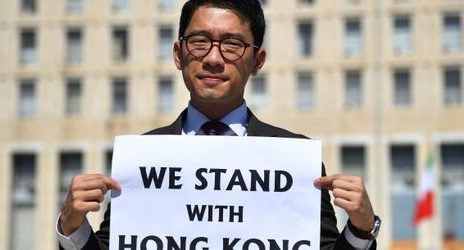
There’s a new idea for a Ukraine no-fly zone. It doesn’t work any better than the old one.
Since the beginning of Russia’s war on Ukraine, calls for a NATO-imposed no-fly zone over Ukraine have been hampered by one big problem: Enforcing a no-fly zone would necessarily entail shooting at Russian planes and carry a significant risk of leading to a nuclear exchange. This argument has carried the day in the White House, which has repeatedly ruled out a no-fly zone or any other direct intervention in the war.
But as the war grinds on and casualties pile up, calls for a no-fly zone have grown, including in some influential circles.
Over the weekend, Sen. Joe Manchin (D-WV) signaled openness to the idea, as have other members of Congress. On Tuesday, Politico published an open letter calling for a “limited” no-fly zone over parts of Ukraine signed by 27 leading experts, including a former supreme allied commander of NATO and two former US ambassadors to the alliance. The basic idea would be to deploy NATO assets to prevent Russian jets and helicopters from flying over certain parts of Ukraine to allow for refugee evacuation and the provision of humanitarian aid.
Calls for a limited no-fly zone suffer from the same basic problem as a broader campaign: You can’t implement one without greatly heightening the risk of nuclear escalation.
“I can only see two reasons [for proposing this]: They have no idea what they’re talking about or they’re posturing,” says Robert Farley, a political scientist at the University of Kentucky who studies airpower.
Moreover, there is no kind of no-fly zone — limited or otherwise — that would address the humanitarian crisis motivating such calls. Russia’s primary method of bombarding civilian-populated areas in this war has been artillery, not aircraft — which means that a Western intervention focused on shooting down planes would either prove ineffective or else escalate to something even more dangerous.
But the calls for a no-fly zone keep coming anyway: relics from prior wars waged under unquestioned American supremacy, unburdened by the prospect of great-power war and nuclear escalation.
Limited no-fly zones, explained
Before I explain what a limited no-fly zone is, let me explain what it is not. This:
Separately, some members of congress are beginning to advocate for a non-kinetic no-fly zone – something to the effect of using electromagnetic pulse, sonar, and cyber to keep Russian jets on the ground so they can never take off. Unclear how much support this will end up getting
— Jacqui Heinrich (@JacquiHeinrich) March 7, 2022
Contra Fox News correspondent Jacqui Heinrich’s sources, this technology doesn’t exist. Or as Dartmouth professor Jason Lyall tweeted, “This is magic. You’re talking about magic.” (Former Air Force officer and Virginia Republican Rep. Denver Riggleman put it even more colorfully: “chucklehead madness.”)
So what exactly is a no-fly zone? No-fly zones are a commitment to patrol and, if necessary, shoot down military aircraft that fly in the declared area, generally for the purpose of protecting civilians.
In Ukraine, that would mean the US and its NATO allies sending in jets to patrol Ukraine’s skies — and being willing to shoot down any Russian planes that enter protected airspace. Since Russian planes are flying combat missions in Ukraine and show no signs of stopping, any no-fly zone puts us on a direct path to a shooting war between the world’s largest nuclear powers.
Limited no-fly zones are supposed to be a way around this problem. By only operating in certain areas of Ukraine, they in theory limit the risk that NATO would need to fire on Russian aircraft to enforce their mandate.
To this end, the authors of the open letter argue that the US and its allies should only commit to protecting “humanitarian corridors” — slices of Ukrainian territory that Moscow and Kyiv have designated as routes for civilian evacuation and aid provision. Such corridors were employed in the Syrian civil war but were frequently violated by Syria and its Russian allies; Ukraine has already accused Russian forces of attacking designated areas in the current conflict.
The letter’s authors argue that a NATO commitment to protect those corridors would not lead to direct fighting with Russia, but would effectively deter the Russians from attacking them again: “What we seek is the deployment of American and NATO aircraft not in search of confrontation with Russia but to avert and deter Russian bombardment that would result in massive loss of Ukrainian lives.”
There are some dire problems with this logic.
First, it inflates the deterrent power of a no-fly zone. The assumption that Russia would be deterred from attacking these areas by a NATO presence flies in the face of past experience. After NATO imposed a no-fly zone over Bosnia in 1993, its jets had to shoot down Bosnian Serb aircraft that flew into the protected airspace. It is hard to imagine that President Putin’s Russia is significantly more afraid of confronting NATO than the vastly inferior Bosnian Serb forces.
Second, setting aside shootdowns of Russian planes, securing even a “limited” no-fly zone would likely require NATO to go on offense. As the Atlantic Council’s Damir Marusic points out, anti-aircraft batteries in Belarus and Russia have enough range to cover the entirety of Ukrainian airspace. Unless NATO pilots wanted to fly with the constant fear of being shot down, they would need to take those out. Attacking Russian territory, like shooting down their planes, is, of course, an act of war on Russia.
Third, a no-fly zone would in fact do relatively little to protect Ukrainian civilians. One of the more striking features of the Ukraine conflict to date has been the surprisingly limited role of Russia’s air force, which has flown only questionably effective missions in Ukrainian airspace. Russia has still bombarded civilian-populated areas, but has primarily done so using artillery rather than airstrikes. A no-fly zone might not even solve the crisis of Ukrainian civilians being pummeled by the Russian military.
All of these factors cast doubt on the desirability of any no-fly zone, limited or not.
If the mission stays restricted to simply denying Russia’s ability to fly in Ukrainian air space, it would almost certainly guarantee clashes with Russian aircraft and air defenses without even stopping the killing of civilians. Moreover, what could follow from that would be risky “mission creep”: The continued mass death could create significant pressure on the US and NATO to target Russian artillery, similar to the way that a 2011 no-fly zone in Libya swiftly escalated to a regime-change operation that ultimately toppled Muammar Qaddafi’s government.
There is, in short, no such thing as a “limited” no-fly zone in Ukraine. Either NATO is using its forces to deny airspace to Russian jets, or it is not. And if the US and its allies engage in such a mission, the logic of the mission inevitably militates toward war with Russia — with all of the risks of nuclear escalation that entails.
Ukraine and the “unipolarity hangover”
So if even a limited no-fly zone is obviously dangerous, why are some leading experts and members of Congress entertaining it?
For one thing, there’s no denying that the situation in Ukraine is horrible. The suffering on the ground and the appeals for intervention from Ukrainian President Volodymyr Zelenskyy — who just desperately wants NATO to help protect his country from a Russian invasion — have struck a chord.
But part of a no-fly zone’s appeal in Washington is grounded in a particular post-Cold War instinct. One helpful way of thinking about this comes from Nick Miller, a professor at Dartmouth who studies nuclear weapons. Miller warns that some American foreign policy thinkers suffer from what he terms a “unipolarity hangover,” defined as “a condition where the afflicted advocate policies feasible against weak adversaries but possibly suicidal against major power rivals.”
Americans, to extend the metaphor, became drunk on power after the fall of the Cold War, becoming convinced that it could and should intervene in faraway conflicts to protect civilians and enforce its vision of global order. This led to campaigns shaped by liberal interventionism and the war on terror, such as the missions to stop mass killings in Kosovo and topple Saddam Hussein.
In the kind of wars that have preoccupied America for most of the post-Cold War period, policies like a no-fly zone made a certain kind of sense. Given the relatively rudimentary air forces and defense of America’s opponents, it was not difficult for the world’s leading airpower to seize control over the skies with few major risks. The question was not whether the United States could accomplish this goal, but whether it should.
When faced with a nuclear-armed major power, be it a rising China or even a militarily inferior Russia, the low-cost logic behind a no-fly zone doesn’t apply. American planes would have to contend with serious air defenses; regime change operations run a major risk of triggering nuclear annihilation.
With the “could” question largely foreclosed for these reasons, the “should” question no longer even comes into play. Yet Americans afflicted with a unipolarity hangover do not recognize this reality. They are still operating in a world of shoulds rather than coulds, one where the United States really can “do something” in the major conflicts of the day without risking unacceptable consequences.
This is not a question of morality versus interests, as foreign policy choices are so frequently framed. There is no coherent moral view in which it would be better to stop Russian planes from bombing Kyiv while significantly raising the risk of a nuclear war. Kyiv is, notably, located on planet Earth.
The poverty of the arguments for a no-fly zone in Ukraine, together with their continued prominence in public discourse, points to how many Americans still have unipolarity hangovers. Things would be better if they could sleep it off.





